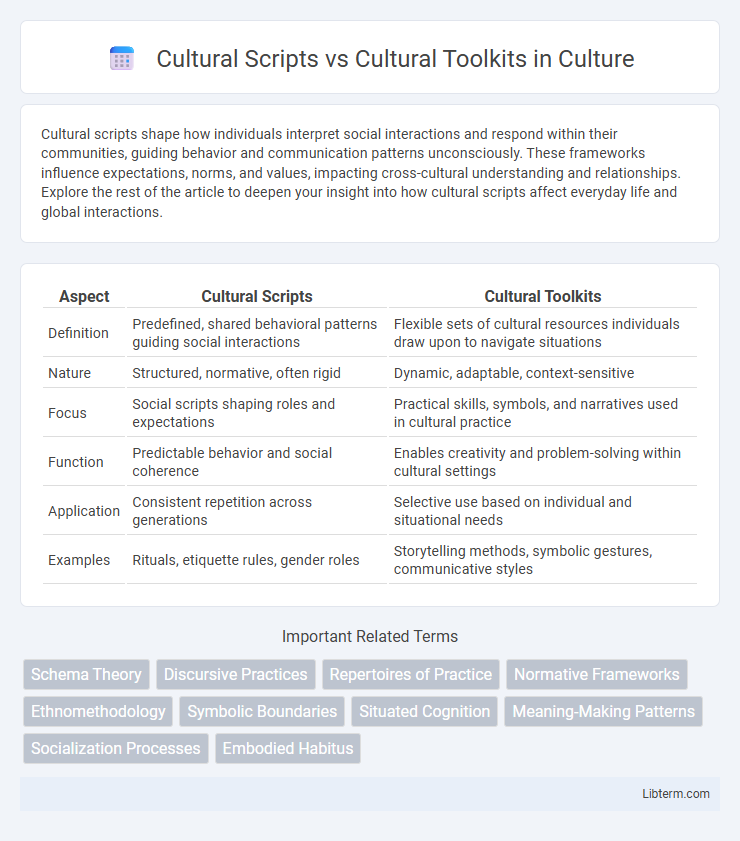Cultural scripts shape how individuals interpret social interactions and respond within their communities, guiding behavior and communication patterns unconsciously. These frameworks influence expectations, norms, and values, impacting cross-cultural understanding and relationships. Explore the rest of the article to deepen your insight into how cultural scripts affect everyday life and global interactions.
Table of Comparison
| Aspect | Cultural Scripts | Cultural Toolkits |
|---|---|---|
| Definition | Predefined, shared behavioral patterns guiding social interactions | Flexible sets of cultural resources individuals draw upon to navigate situations |
| Nature | Structured, normative, often rigid | Dynamic, adaptable, context-sensitive |
| Focus | Social scripts shaping roles and expectations | Practical skills, symbols, and narratives used in cultural practice |
| Function | Predictable behavior and social coherence | Enables creativity and problem-solving within cultural settings |
| Application | Consistent repetition across generations | Selective use based on individual and situational needs |
| Examples | Rituals, etiquette rules, gender roles | Storytelling methods, symbolic gestures, communicative styles |
Understanding Cultural Scripts: Definitions and Examples
Cultural scripts refer to the shared, often unconscious, patterns of behavior and communication that guide social interactions within a specific culture, such as greeting styles or conversational norms. These scripts serve as mental frameworks that individuals internalize, shaping expectations and responses in routine situations, for example, the Japanese bow or the American handshake. Understanding cultural scripts is essential for effective cross-cultural communication, as it reveals how culture influences behavior without explicit instructions.
What Are Cultural Toolkits?
Cultural toolkits refer to the set of behaviors, skills, and symbolic resources individuals draw upon to navigate social life and solve problems. These toolkits include language, customs, norms, and rituals that are learned and shared within a cultural group. They provide flexible guidelines that individuals use to interpret situations and make decisions, differentiating them from rigid cultural scripts.
Key Differences Between Cultural Scripts and Toolkits
Cultural scripts are shared, normative patterns of behavior and communication deeply embedded in a society's collective memory, guiding everyday interactions with predictable social roles and expectations. Cultural toolkits consist of a repertoire of symbols, stories, rituals, and habits that individuals selectively draw upon to navigate diverse social situations, allowing for flexibility and adaptation. The key difference lies in cultural scripts being relatively fixed and prescriptive, whereas cultural toolkits provide a dynamic set of cultural resources enabling individuals to creatively construct their social identities.
How Cultural Scripts Shape Social Behavior
Cultural scripts are ingrained patterns of behavior and communication that guide individuals' actions within a society, shaping social interactions through shared expectations and norms. These scripts influence how people interpret social situations, regulate emotions, and respond to others, creating predictable and coherent social behavior. Unlike cultural toolkits, which offer a range of flexible strategies, cultural scripts provide stable frameworks that standardize behavior across similar contexts.
The Role of Toolkits in Daily Decision Making
Cultural toolkits function as flexible sets of habits, skills, and symbols that individuals draw upon to navigate daily decisions within specific social contexts. Unlike rigid cultural scripts, these toolkits allow for adaptive problem-solving by providing diverse options tailored to evolving circumstances. By integrating elements from multiple cultural sources, toolkits empower individuals to creatively address challenges and shape behaviors in everyday life.
Historical Evolution of Cultural Scripts
Cultural scripts evolved as structured, socially shared patterns guiding language use, behavior, and cognition within specific historical contexts, reflecting the dynamic interplay of social norms and power structures. Their historical evolution demonstrates how cultural meanings and communicative practices adapt to changing societal conditions, influencing identity formation and group cohesion. Unlike cultural toolkits, which comprise a flexible repertoire of practices and symbols, cultural scripts represent more stable, codified frameworks rooted in historical legacies and collective memory.
Toolkits and Adaptation to New Contexts
Cultural toolkits encompass flexible sets of practices, symbols, and skills that individuals draw upon to navigate and adapt behavior in diverse social contexts. Unlike rigid cultural scripts, toolkits allow for creative recombination and modification, enabling effective responses to novel or changing situations. This adaptability supports individuals' capacity to reinterpret cultural resources dynamically, facilitating integration within new environments and cross-cultural interactions.
Intersections and Overlaps: Scripts Within Toolkits
Cultural scripts function as specific, shared guidelines for behavior and communication embedded within broader cultural toolkits, which contain a diverse set of practices, symbols, and narratives available for social navigation. The intersection between scripts and toolkits lies in how scripts provide repeated, recognizable patterns that individuals draw upon from their toolkits to interpret and respond to social situations efficiently. This overlap enables the dynamic use of cultural resources, allowing individuals to adapt scripts from their cultural toolkit to fit varying contexts while maintaining coherent social interaction.
Impacts on Identity Formation and Group Dynamics
Cultural scripts provide structured narratives and behavioral expectations that shape individual identity by embedding social norms, while cultural toolkits offer a flexible set of resources individuals draw upon to navigate diverse social situations and construct multifaceted identities. The interplay between cultural scripts and toolkits influences group dynamics by balancing conformity with adaptability, enabling groups to maintain cohesion while accommodating internal diversity. This dynamic process affects identity formation by allowing individuals to internalize collective values through scripts and tailor their behavior using toolkits, thereby reinforcing or transforming group boundaries and social roles.
Implications for Cross-Cultural Communication
Cultural scripts refer to shared, implicit guidelines that shape behavior and interactions within a specific cultural group, while cultural toolkits consist of a variety of cultural resources individuals draw upon to navigate social situations. Understanding cultural scripts helps decode predictable patterns in communication, whereas cultural toolkits emphasize adaptability and individual agency in cross-cultural contexts. Effective cross-cultural communication requires recognizing both the standardized behaviors shaped by cultural scripts and the flexible use of cultural toolkits to prevent misunderstandings and foster mutual respect.
Cultural Scripts Infographic

 libterm.com
libterm.com